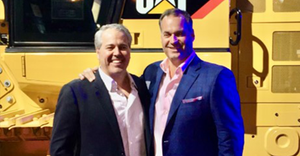
Each year 23 million tons of food get wasted, worth $201 billion, while tens of millions of people are food insecure. There are some innovative companies working to address this environmental, financial and social problem. Representatives of three such up-and-coming businesses highlighted their work at Waste Expo session: Innovations and Solutions in Food Waste Prevention, Reduction and Recovery. The session was moderated by Stuart Buckner, Buckner Environmental Associates, and the speakers were Max Mlinar, Phood Solutions; Daniel Kurzrock, ReGrained; and Jennifer England, Food Rescue Hero.
ReGrained upcycles food and got its start using grain left from brewers’ beer-making process to make nutrition bars and snacks. Now it also works with multinational partners, leveraging its technology to introduce ingredients in products from vegan banana bread to cookie dough using oats, fruits, vegetables, legumes and nuts from manufacturing.
“What we are doing is an old idea; improving how we value resources and putting food to its highest use. At the same time, we address the climate crisis,” Kurzrock said.
Upcycled food contains ingredients that would not have gone to human consumption. It’s a growing trend, and a revenue-generating one. It’s a $47 billon dollar market according to Kurzrock, and Whole Foods just named upcycled food among the top 10 food trends for 2021.
The concept has driven interesting changes in how food is used; he pointed to cheese.
“Cheesemaking has always used the byproduct, whey. Now whey producers are using cheese as the byproduct. It’s food that was not going to human consumption, so a value-added market was created.
These products can be certified. Among standards for certification are to prove food loss diversion and minimum upcycled ingredient amounts through a supply chain audit.
ReGrained’s technology can be set up at processors’ sites. The company is still also creating its own products.
There are two pillars of upcycled food: manufactured byproducts where input from one company comes from another company’s output. The other is leveraging surplus and imperfect produce from farms.
The byproducts have been the big focus lately. “What we are doing with byproducts is almost like re-harvesting, and we can do more with less,” Kurzrock said.
Phood Solutions uses vision technology to make tracking of food easier, which is helping companies reduce waste by as much as 50%. It’s targeting businesses with sustainability goals as we move closer to the U.S. Environmental Protection Agency’s goal of a 50% reduction in food waste by 2030.
Some companies are slow to buy into food waste reduction technologies.
“They see a waste problem but do not see solutions as being easily implemented and cost effective,” Mlinar said.
“We are trying to show them that machine learning and predictive analytics are easy, hands-off technologies to collect data and to make more educated decisions.”
Education helps to put public pressure on businesses to be more open about sustainability initiatives, and food waste reduction solutions are part of this.
Source reduction is the most effective, and applied machine learning and predictive analytics are some of the tools that can be put to use to achieve this.
It’s leveraged to create probability models to do more accurate forecasting and more precise ordering. It’s done with camera recognition models to track food waste to know its source, to leverage those insights to alter production, and to help with menu planning.
But while these smart technologies help to achieve pretty good reduction numbers there’s more to be done that Mlinar figures is best achieved through a multipronged approach.
“We have relationships with companies that do anaerobic digestion and food donation, and partnerships like these are important to drive the most impact,” he said.
“It’s also about educating stakeholders and making them aware of what solutions are out there.”
England discussed food recovery work and the model that Food Rescue Hero employs to address a distribution problem.
“A traditional model sends out trucks to each location and takes food to a central point for distribution. It’s not as easy as it may seem,” she said.
It’s hard to get the right food to the right place and at the time it needs to be there. It’s especially challenging when trying to move smaller quantities and perishable foods.
Food Rescue Hero’s has dispatchers who receive donations and match them with nonprofits, based on their needs. It has an Uber-like system where volunteer drivers near a given receiving location are pinged when food is ready to be picked up and delivered.
There are 23,000 volunteers in 12 cities.
“Our dispatchers know how long food has been on the road. And we provide food safety training to volunteers who distribute it, so it’s handled quickly and appropriately.
We miss only one percent of rescues and have rescued 55 million pounds of food and distributed to 2,800 nonprofits,” England said.
The organization partners with the Housing Authority of Pittsburgh to distribute large volumes of food fast.
Within five to seven months of entering into this relationship the city was getting no emergency calls from residents who had no food; they were receiving it at their doors, which was key.
The team has since done a study looking at poverty, food access, and transit. We distributed directly to homes of people with severe access limitations.
Of survey responders, 90 percent reported improvements in food security; 86 percent said they were eating healthier; and 77 percent felt more connected to the community because as the food was distributed people were interacting with their neighbors in ways they hadn’t before.
“We want to work with more partners – those who are making changes in their communities because they understand their communities more than we do,” England said.
About the Author(s)
You May Also Like




